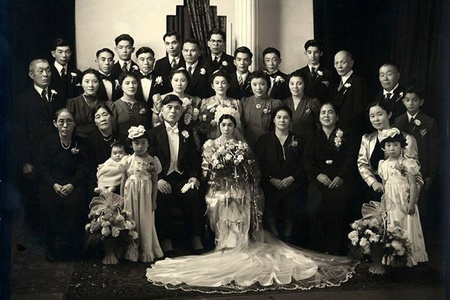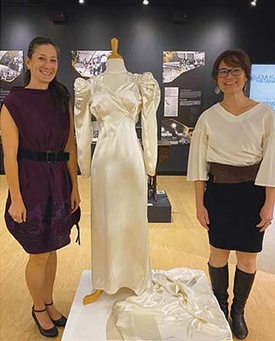
For authors and cousins Janis Bridger and Lara Okihiro, family stories and history were shared in bits and pieces at their grandparents’ dining room table. This is how their new children’s book Obaasan’s Boots begins, with Charlotte and Lou full of questions and hungry to learn more about their family history after dinner at their grandparents’ home.
A chapter book for 9 to 12-year-olds, Obaasan’s Boots is told through the perspectives of cousins Charlotte and Lou and their grandmother, Hisa, who invites the girls to spend the day helping her in the garden. As they pick strawberries, stake tomato plants, and water snow peas, Hisa shares her story. Charlotte and Lou learn not only about Japanese Canadian history but begin to understand how their identities have been shaped by racism and how history is not only about the past.
Released in October, Obaasan’s Boots was written by Lara Okihiro, a Toronto-based writer and former lecturer at the University of Toronto, and Janis Bridger, a teacher-librarian in New Westminster. The story is based on the experiences and memories of their grandmother, Hisa Okihiro (nee Nakazawa).
Okihiro and Bridger are both educators and parents and part of the impetus to create this book was seeing a void in children’s literature around Japanese Canadian history.
“[Recently] there has been a renaissance in those oppressed voices being highlighted and pushed to the forefront. It’s gone on too long that these voices haven’t been heard, and their stories and history haven’t been shared,” Bridger tells Nikkei Voice in an interview.
Originally meant to be a picture book, Bridger and Okihiro’s publisher, Second Story Press, encouraged expanding Obaasan’s Boots into a chapter book for an older audience. While it required more work and research, it also allowed space to create dimensional and complex characters whose stories are a lesson in history and empathy for young readers.
“Putting yourself in the shoes of another person and then having to spend time with their story for a little bit—which was even our experience, having to put ourselves in Grandma’s shoes and then think about those really difficult details—hopefully, that’s what we’ve done for readers,” says Okihiro.
Okihiro and Bridger hope the book can be a tool for educators to teach Japanese Canadian history to children. In 2015, the BC government overhauled parts of the school curriculum, emphasizing grade 5 and 10 students learn about past wrongs in Canadian history, such as the Japanese Canadian internment, Chinese head tax, residential schools, and the Komagata Maru incident. “While an important change, if teachers don’t have the age-appropriate resources, they cannot properly teach these histories,” says Bridger.
Even adults have shared that the book is an accessible way to approach a difficult part of Canadian history they never learned about in school.
“Often the textbooks or history books are missing that emotional element, and with a children’s book, or any fiction or historical fiction, because you are adding emotion and characters, there is maybe a broader, more accessible understanding that makes it more real, it’s not just a bunch of numbers or facts,” says Bridger.
The cousins wrote based on stories they heard directly from Hisa, their parents, and family members, as well as Hisa’s notebooks and filmed interviews. They explored historical archives, directories, documents, photographs, and their family files in the Landscapes of Injustice database. Okihiro has extensively studied, written, and lectured on the Japanese Canadian internment in literature, and Bridger has continued the family history research that her mother started years earlier. Their research also led to New Westminster city council reading an official proclamation honouring the history of Japanese Canadians in the city in 2022.
As Hisa tells her story, readers are transported to the different parts of her life, from early memories of hard work in a cannery village on Sea Island, B.C., to being interned with a five-week-old baby in Kaslo, to her family dispersing across Canada after the war.
The character of Hisa is a bit of fiction mixed with non-fiction, but it was important to convey her in the ways the authors remembered her. She was hardworking, working as a housekeeper until she was 82. She was kind and welcoming, and family was always precious to her, often hosting family dinners at her home.
“Although she was a tiny woman, she’s left big boots to fill because of who she was and how she carried herself,” says Bridger.
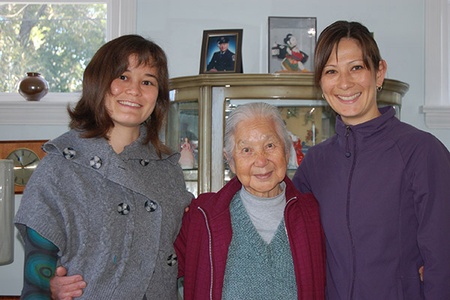
Parts of Hisa’s character are based on how Okihiro or Bridger imagined they might feel in their grandmother’s situation. In the first weeks of her first son’s life, she was packing away their home, getting ready to board a train and leave their lives in New Westminster behind, with no certainty that she would ever return. Okihiro imagines in times like these, her grandmother would be angry because she would be angry.
“Grandma was a very strong woman. She was a very firm woman. As I got older, I realized you didn’t want to cross her. She was always such a loving person, but there was also a side to her that would stand her ground in her quiet kind of way,” says Okihiro.
As the granddaughters listen to Hisa’s story, they act as mediators for young readers. The two girls discuss what they’re learning for the first time, processing that this did not just happen to someone in the past but to their grandmother, who now stands in front of them today.
As Hisa describes being separated from her sister and parents for years, only able to communicate through censored letters, they imagine not having your cellphone to contact your family whenever you need them. When Hisa describes packing up her home, the girls imagine what they would pack if they had to leave. What would happen to their rooms, their things, their pets? Or when Hisa describes the tiny space she lived in, the girls pace the garden, tracing out the floor plan, something they hope young readers will try doing.
“By learning about this past wrong, and other past wrongs, my hope is that they understand that they can’t go back and change history, but making the effort and giving themselves the opportunity to hear these different histories and stories provides them [with] or builds that empathy that they become kind, compassionate leaders who won’t allow this to happen again,” says Bridger.
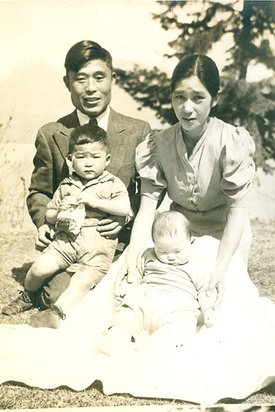
Lou and Charlotte also reflect how the trauma of the Japanese Canadian internment has trickled through families. While coming from the same family, Charlotte and Lou have different experiences. Like Bridger, Charlotte grew up in B.C., while like Okihiro, Lou grew up in Toronto. With their different perspectives and knowledge on their family history and identity, it sets the scene for the mystery of their family history and why they are separated.
“I think it highlights that even though a family has the same history, there are different perspectives and different members of the family hear different stories and react differently,” says Bridger.
“I think history is like that too, there are different perspectives, and I think there’s a better understanding, a more respectful empathetic way, the more versions we hear from different perspectives.”
Both cousins hope that while this book can be educational, it can also be healing for their own family and the trauma that lingers. For Okihiro, her father’s story is very much a part of this book, he is the newborn baby Hisa brings to Kaslo. Labelled an enemy alien at just five weeks old, spending the beginning of his life in an internment camp, and growing up experiencing postwar racism, Okihiro is curious how he will respond to the book.
Already, the book has been a connecting force for the family. To write the book, they reconnected with family to hear stories or find family treasures dispersed among the family. For other parts, the cousins spoke to their great uncle Isi Nakazawa, Hisa’s last surviving sibling. At 99, he still has an incredible memory, remembering details that helped bring their book to life.
The book brought the family together during the launch at the Japanese Canadian Cultural Centre on Oct. 5. Serendipitously, the launch was on the fourth anniversary of Hisa’s passing. “It was the first time the family was all together since her funeral and the pandemic,” says Okihiro.
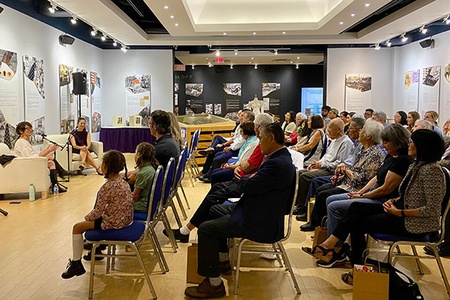
Researching Hisa’s story gave the cousins a better appreciation for why she always hosted family gatherings. From losing her beloved older brother to hearing stories of how her mother longed to visit her family in Japan and her incredibly close bond with her sister Jeanne, family was important to Hisa.
“She was the only one of the Nakazawa children, her siblings, who went out east, and the rest stayed in the west, and they were so tight and so close together, and it just makes you wonder what things would have been like for the families,” says Okihiro. “She must have missed having family and being so close to everyone.”
For Okihiro and Bridger, working on the book has also brought them closer together. From appointments to kids to pets, they were talking on a weekly and sometimes a daily basis while working on the book. Again, their grandmother brought them together.
“For me, coming out to Toronto was always to see Grandma and family, and her house was the meeting place. I have a new meeting place now, and I feel so welcomed, and it’s just lovely to have a connection,” says Bridger.
Bridger and Okihiro hope Obaasan’s Boots inspires young readers to not only learn about Japanese Canadian history but also their histories and to spend time asking their families questions.
“To share stories, spend time with each other, talk to your elders, sit around the table drinking tea with them or making and eating food, or spending time in the garden, or whatever it is, I think that’s one hope,” says Okihiro.
“The best teachers and the knowledge keepers are right there in front of you, your family, and they’re not going to be there forever, so read, talk to your elders, your family, collect your own story. Everybody has their own story,” says Bridger.
*This article was originally published in The Nikkei Voice on November 28, 2023.
© 2023 Kelly Fleck



